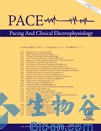PACE:房颤射频消融围手术期患者使用达比加群优于华法林
2012-12-28 PACE 互联网 倚天观海
达比加群是新开发的一种直接抑制凝血酶的抗凝药物,其抗凝效应受饮食和合并用药的影响较小。另外,它在使用中无需监测凝血时间或调整剂量。RELY试验(长期抗凝治疗的随机化评估研究)在房颤患者减少卒中和出血并发症方面,达比加群非劣于华法林。为了评估这一结论是否也适用于进行房颤射频消融治疗的围手术期患者,已进行了两项研究。但两者均为非随机对照研究。为此TAKAMITSU NIN等设计了一项随机研究,试图评估
达比加群是新开发的一种直接抑制凝血酶的抗凝药物,其抗凝效应受饮食和合并用药的影响较小。另外,它在使用中无需监测凝血时间或调整剂量。RELY试验(长期抗凝治疗的随机化评估研究)在房颤患者减少卒中和出血并发症方面,达比加群非劣于华法林。为了评估这一结论是否也适用于进行房颤射频消融治疗的围手术期患者,已进行了两项研究。但两者均为非随机对照研究。为此TAKAMITSU NIN等设计了一项随机研究,试图评估达比加群与华法林应用于房颤射频消融术围手术期患者的有效性和安全性。
研究连续入选拟进行房颤射频消融治疗的患者共90例,随机分配为达比加群治疗组45例和华法林治疗组45例,比较两组的临床可行性。两组均于术前一天停用抗凝药物,术后确认静脉穿刺点止血确切后重新使用。两组患者均为在停药期间使用肝素。
研究中有三名服用达比加群的患者,因发生消化不良改用华法林。达比加群组静脉穿刺点再次出血发生率低于华法林组(20% vs 44%;P = 0.013)。服用药物后,达比加群组D-dimer水平下降幅度较华法林组。服用抗凝药物至进行消融手术的时间,在达比加群组明显短于华法林组(43±7 vs 63±13天;P< 0.0001)。研究对象中仅有一例发生致命性并发症,为服用华法林治疗患者在消融术后出现肠系膜动脉栓塞。
TAKAMITSU NIN等由此得出结论,射频消融术围手术期患者,使用达比加群可能在减少围手术期小出血风险和高凝状态以及可进行消融手术时长方面,均优于华法林。
与房颤相关的拓展阅读:
- Heart Rhythm:服用达比加群的房颤患者行消融术是安全的
- CIRCULATION:非阵发性房颤患者导管消融的临床预后仍不理想
- 全国首家房颤消融手术万例医院揭牌
- BMJ:亚临床甲状腺病房颤风险升高
- Circulation:肾功能不全独立预测房颤卒中风险 更多信息请点击:有关房颤更多资讯

doi: 10.1111/pace.12036
PMC:
PMID:
Nin T, Sairaku A, Yoshida Y, Kamiya H, Tatematsu Y, Nanasato M, Inden Y, Hirayama H, Murohara T.
BACKGROUND: We aimed to evaluate the feasibility of an oral direct thrombin inhibitor, dabigatran, as a periprocedural anticoagulant for use with ablation of atrial fibrillation (AF). METHODS: Consecutive patients scheduled to undergo an AF ablation were randomly assigned to receive dabigatran (n = 45) or warfarin (n = 45) to compare their clinical feasibility. Both of those oral anticoagulants were discontinued the day before the ablation and were resumed after confirming hemostasis of the venipuncture site. A bridging therapy with heparin was not used in either of the patient groups. RESULTS: Dabigatran was switched to warfarin before the ablation because of dyspepsia in three patients. An occurrence of rebleeding from the venipuncture site was less common in dabigatran-allocated patients than in warfarin-allocated patients (20% vs 44%; P = 0.013). The reduction in the D-dimer level after the initiation of oral anticoagulants was greater in the dabigatran-allocated patients than in the warfarin-allocated patients. The time from the initiation of the anticoagulants to the ablation was significantly shorter in the dabigatran-allocated patients than in the warfarin-allocated patients (43 ± 7 vs 63 ± 13 days; P < 0.0001). There was only one fatal periprocedural complication in a patient receiving warfarin, who had a mesenteric arterial thrombosis after the ablation. CONCLUSIONS: An anticoagulation strategy with dabigatran may surpass that with warfarin in reducing both the periprocedural risk of minor bleeding and a hypercoagulable state, and the time to ablation in patients undergoing ablation of AF.
本网站所有内容来源注明为“梅斯医学”或“MedSci原创”的文字、图片和音视频资料,版权均属于梅斯医学所有。非经授权,任何媒体、网站或个人不得转载,授权转载时须注明来源为“梅斯医学”。其它来源的文章系转载文章,或“梅斯号”自媒体发布的文章,仅系出于传递更多信息之目的,本站仅负责审核内容合规,其内容不代表本站立场,本站不负责内容的准确性和版权。如果存在侵权、或不希望被转载的媒体或个人可与我们联系,我们将立即进行删除处理。
在此留言










#ACE#
63
#手术期#
89
#射频消融#
74
#消融#
70